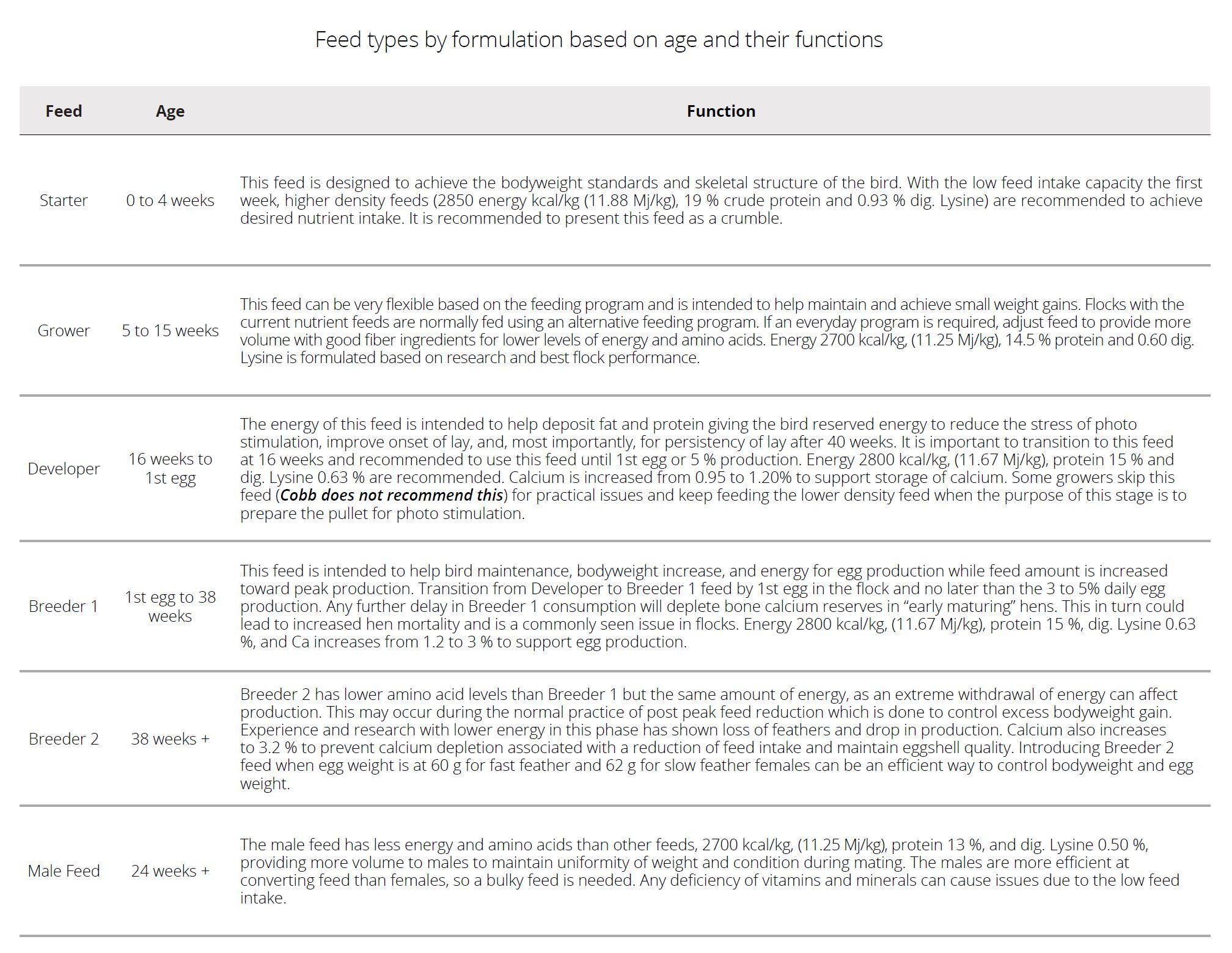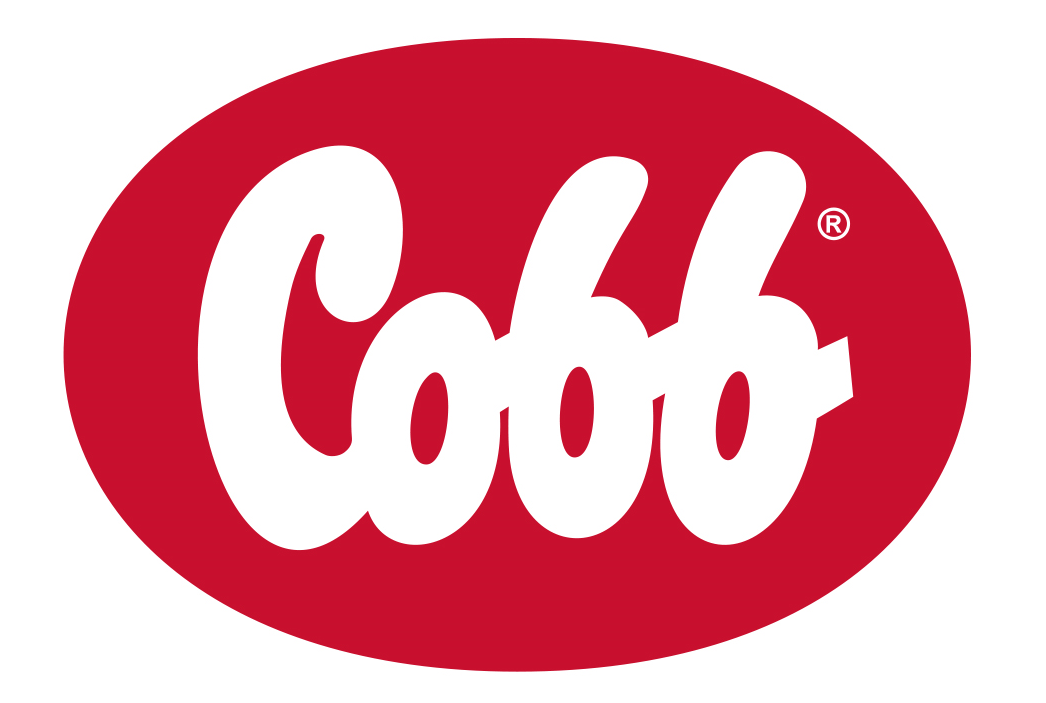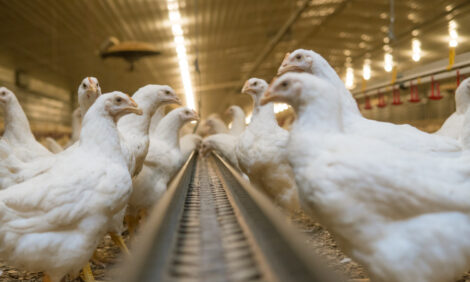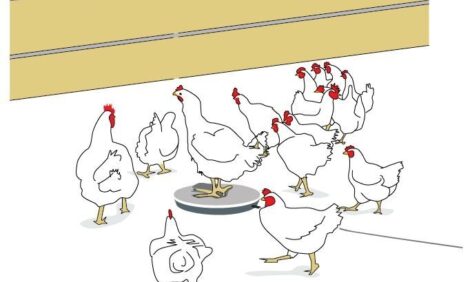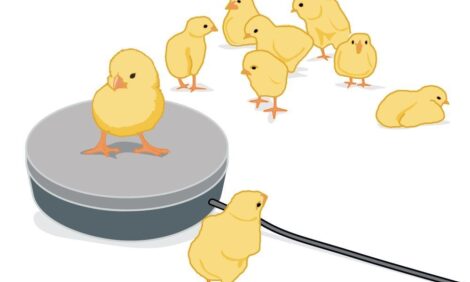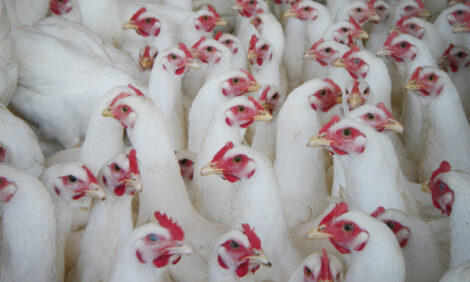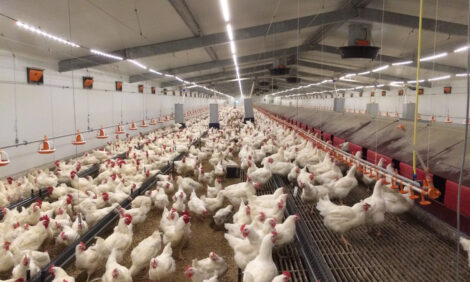



Cobb Breeder Management Guide: Breeder management
Learn more about feed and nutritionPart of Series:
< Previous Article in Series Next Article in Series >
Editor's note: This article is an excerpt from the Cobb Breeder Management Guide and additional articles will follow. The Guide was designed to highlight critical factors that are most likely to influence flock performance. The management recommendations discussed were developed specifically for Cobb products. The recommendations are intended as a reference and supplement to your own flock management skills so that you can apply your knowledge and judgement to obtain consistently good results with the Cobb family of products. To read or download the complete Guide or to view Cobb's other management guides, click here.
The main objective of any broiler breeder operation is to produce fertile settable eggs that, when hatched, will supply the necessary quantity of good quality chicks to meet the broiler production demands. Management in the first week post hatch is a major contributor to any successful breeder management program. Key indicators of flock performance are the average bodyweight, and flock uniformity as well as mortality at day 7. Achieving good flock uniformity during the production phase can be attributed to the technical work done during the rearing phase. However, it is not enough to rely on knowledge and technical skills. Plan, organize, perform and monitor key performance indicators including rearing and production bodyweight curves and feed consumption. It is important to monitor these key indicators and respond early to issues.
The standard bodyweight curve during rearing is a prime example of one of these indicators. Failure to maintain a rearing flock on the standard bodyweight curve can have considerably negative consequences on flock productivity. Managing and monitoring feed consumption requires attention to feed formulation, ingredient choice and feed form to ensure predictability with regards to intake and bodyweight response compared to the standard grams/bird/week. Breeder bodyweight management is also dependent upon the quality of weighing and feeding equipment.
Males should be raised separately from the females up to 20 to 21 weeks of age for best results. Rearing can be broken down into 5-time frames each consisting of 4 weeks and each time frame having important factors involved in the bodyweight curve.
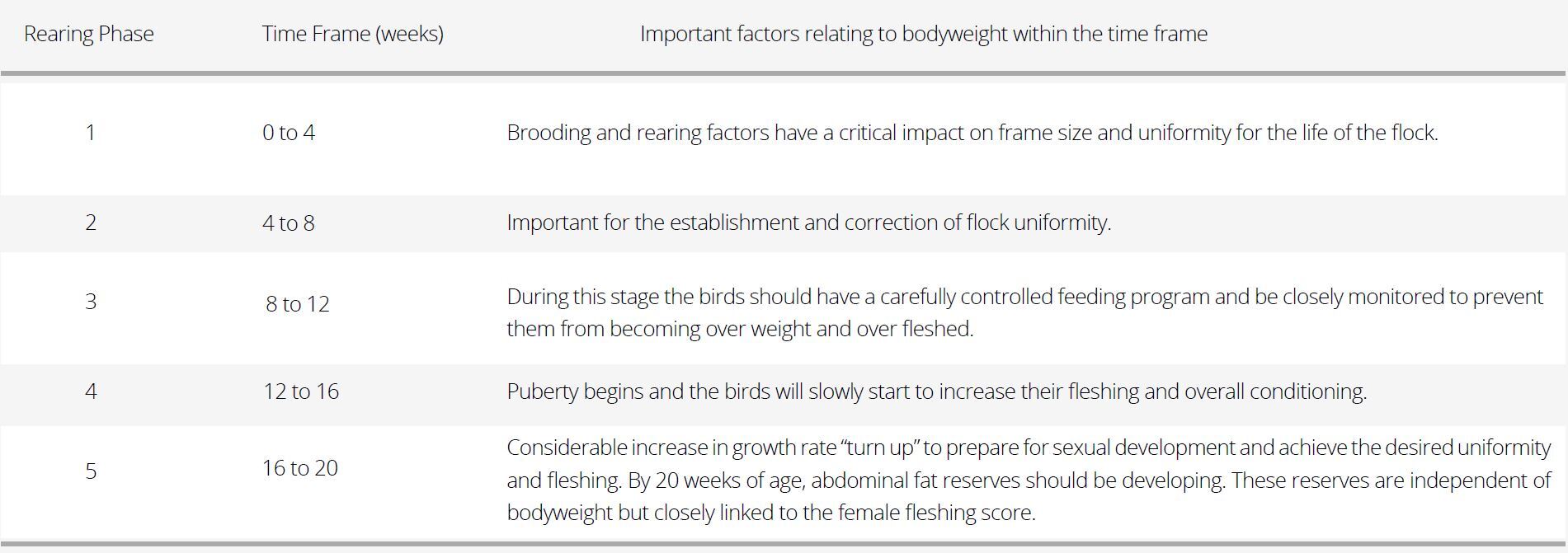
Feed intake
Feed intake time, or feed cleanup time, is a key consideration in both the rearing and production periods. Cleanup times will vary over the rearing period and depend on several important factors including feed amounts, genetic line, the type of feeding program, the feed form presented and light intensity being used in the house.
In the rearing period, pullets will start rapidly cleaning up the feed during the controlled growth phase. Allow a feed cleanup time of about 40 to 60 minutes from 10 weeks of age until photo stimulation. This provides enough time for equal access to feed. If cleanup time is less than 30 minutes, increase feed volume and prolong cleanup time by applying an alternative feeding program such as 5/2 or 4/3. In the production period, hen cleanup time is one of the indicators used to determine the first feed decrease after peak production.
Key dictators of cleanup time are feed texture and size. In rearing and production, we recommend a crumble to prolong feed consumption time. Some producers may use mash coarse feed, which increases consumption time compared to a crumble. We discourage using pelleted feed in rearing or production since it can be consumed quickly and there may not be enough volume to guarantee equal distribution.
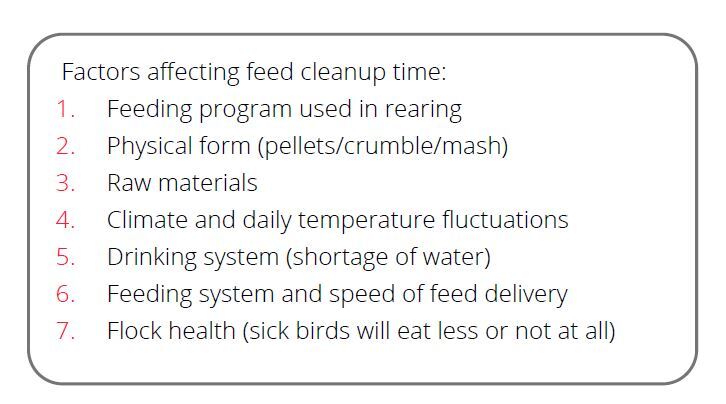
Consistent timing of feed delivery is important for the flock and welfare and is as important as ‘when the birds eat’ (i.e. time of the day) and ‘how often birds eat’ (i.e. feeding program). Birds will learn when to expect food and will adjust accordingly. Irregular feeding schedules or a disruption in the normal feed routine can be very stressful for the flock. Consistent feeding times are necessary for bird health and good welfare outcomes. When transitioning from one feeding program to another, observe flock behavior, cleanup time, and activity level and strive to keep the time point of feeding the same.
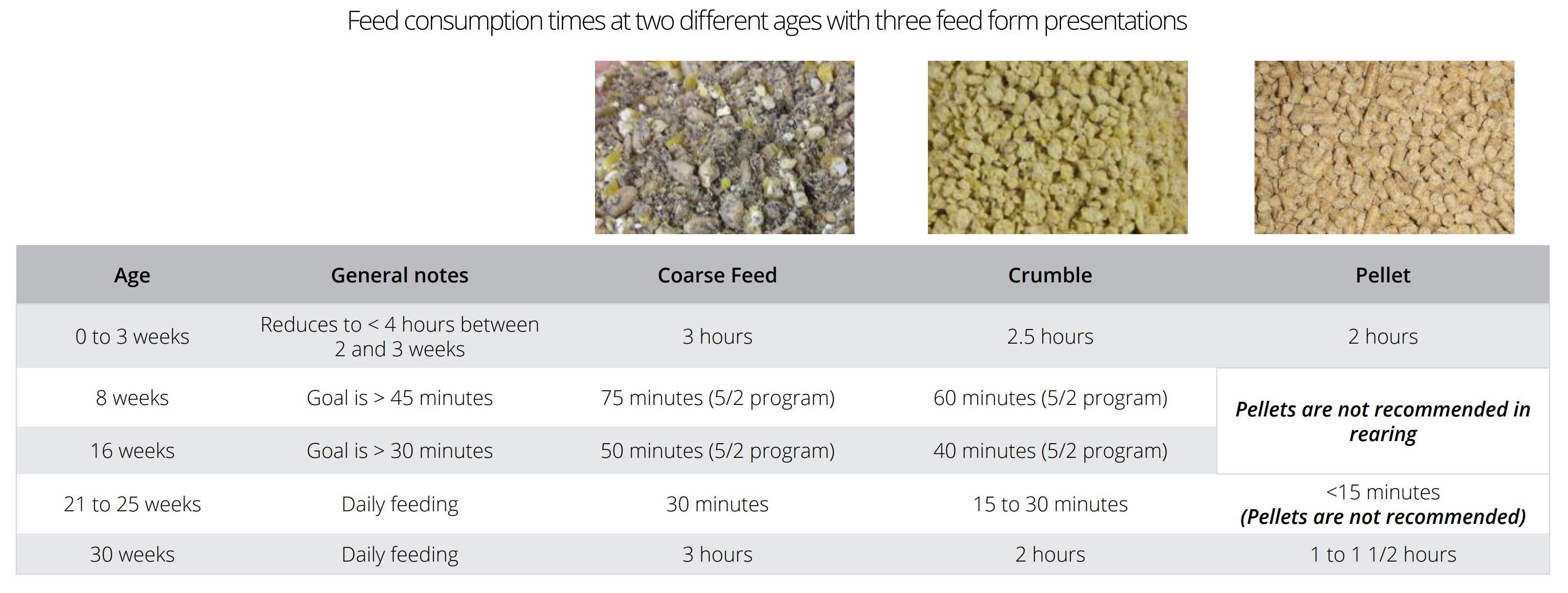
The importance of nutrition
The correct feed formulation and nutritional content is required so that breeders express their genetic potential and produce fertile hatching eggs. Furthermore, high quality ingredients must be used to ensure the hatching eggs are free of contaminants and contain all the nutrients needed for hatching healthy broiler chicks.
The correct feed specifications are a very important factor in rearing and production for high performing flocks. Nutrition plays a key role in preparing pullets for production. Good rearing management with high uniformity and bodyweights on standard will not guarantee good production if the pullets are not conditioned properly due to inferior feed specifications. Consistent results will always be a challenge if the feed is not up to specifications. The feed specifications need to be integrated into the management methods to understand why and how the pullets grow, develop, feather and prepare for photo stimulation. Always purchase good quality feed ingredients and formulate diets based on the Cobb specifications available in our supplements (http://Cobbgenetics.com/reso...).
A standard feeding profile should be followed during rearing to keep bodyweights on the standard curve. Any small deviations from standard in bodyweight can be adjusted with small 1 to 2 g feed increments. Once established, use the feeding program as a general guide during rearing. Bodyweight can fluctuate within +/-2 % of the standard. For consistent performance, prevent changes in feed formulation and monitor each feed delivery. Report any problems immediately. Feed samples should be stored on the farm for testing if necessary.
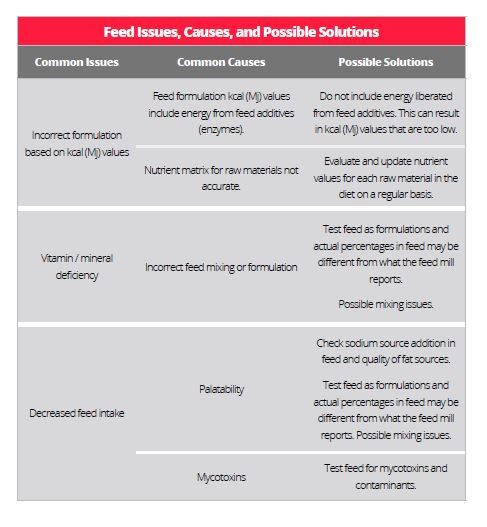
Key points for feed formulation and nutrition
- Collect samples of feed and write detailed notes (date mixed, date received, feed type (starter, breeder 1, etc.)) on the sampling container.
- Conduct regular audits that include sampling and testing of ingredient suppliers and the feed mill.
- Carefully choose feed enzymes and match them with local raw materials as enzymes impact substrates available for microbial fermentation in the bird.
- Use the Cobb feed specifications and be sure to change feeds at the correct flock age (see next page for descriptions of each feed formulation).
